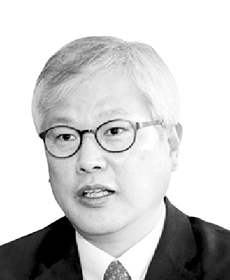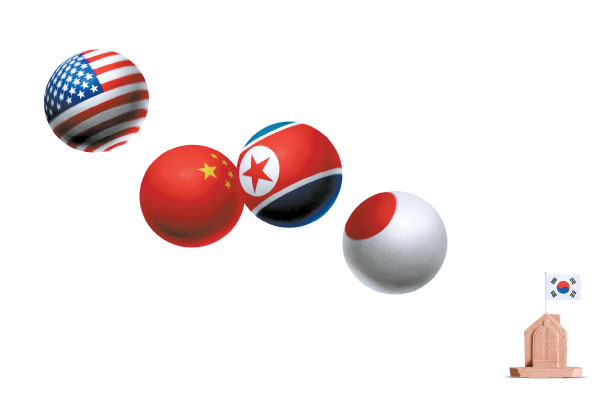Korea’s survival options

The author is a professor of political science and diplomacy at Sungkyunkwan University and the director of the Sungkyun Institute of China Studies.
On July 9, 1971, a group of special envoys dispatched by the U.S. president arrived in Beijing to met in secret with then-Chinese Premier Zhou Enlai after visiting Ho Chi Minh City, Vietnam; Bangkok; New Delhi, and Rawalpindi, Pakistan. In February 1972, U.S. President Richard Nixon traveled to China to sign the Shanghai Communique himself, and in 1979, China formally started enacting economic reforms after establishing diplomatic ties with the United States.
At the center of U.S.-China reconciliation was Henry Kissinger, who served as national security adviser during Nixon’s presidency. The United States aggressively helped China’s economic rise, and China acknowledged the United States’ stance in the Asia-Pacific region. Both countries’ cooperation on halting many conflicts during the Cold War era led to the establishment of the so-called Kissinger Order based on the respect for each other’s values and credos.
But the ongoing trade war between the two superpowers has symbolized a breakdown of the Kissinger Order. As the United States could no longer tolerate China’s ascent — seen in its successful commercialization of cutting-edge technologies and the threat China poses to America’s global hegemony — Washington decided to weaponize the mutual dependence relationship it had with China in the economic sector. The United States also abandoned the global value chain system it helped create to maximize efficiency and spread distrust toward multilateral economic systems like the World Trade Organization.
Buoyed by its new prowess, China also tried to mitigate the U.S. presence in the Asia-Pacific region. It chose the Chinese way of globalization out of the conviction that Asia’s security must be protected by Asians. The U.S.-China conflict will eventually fade as time goes by — primarily because the United States can bully China for the moment, yet certainly cannot block its rise in the longer run. Besides, America’s campaign to prevent China from rising further can hardly result in reinforcement of U.S. competitiveness. As a result, the two rivals have entered a long battle for technological hegemony while trying to reduce their interdependence on security and industrial affairs.
The thoughts and actions that U.S. President Donald Trump has shown during his trade war with China have influenced Japanese Prime Minister Shinzo Abe. For the first time since the end of World War II, Japan pressured South Korea, an ally, to accept political demands through economic restrictions — in part by taking advantage of the limits of American leadership which has long refrained from mediating in historical and territorial issues between its Asian allies. Trump recently said of the Korea-Japan trade row that it has put the United States in a “very difficult position,” adding that the two countries need to “get along with each other,” suggesting a lack of solutions on Trump’s end.
Such a situation owes much to Tokyo’s effort to convince Washington of the need to re-establish Korea-Japan relations since the launch of the pro-Pyongyang administration in South Korea two years ago. Japan will further try to push South Korea out of the traditional Seoul-Washington-Tokyo security partnership and improve ties with Beijing to expand its clout in the region.
The dispute between Korea and Japan also affects China in its ongoing trade war with the United States. Scholars in Beijing interpret the Seoul-Tokyo discord in various ways. First, Japan imposed economic restrictions on Korea to block a possible domino effect of historical and territorial issues in other Asian countries. Second, Japan wanted to slow the pace of Korea to catch up with Japan under the stark circumstances in which Korea’s competitiveness overwhelms its complementary cooperation in key industries. Third, to pull the brakes on South Korea’s rise in East Asia thanks to the narrowed gap between the two countries’ GDP (Korea’s GDP is currently one third of Japan’s). Fourth, Japan is protesting its exclusion from the North Korean denuclearization process.

[CHOI JONG-YOON]
China needs to keep close ties with South Korea to cooperate on the North Korean nuclear issue, and so far, the most plausible ways to bring the two countries closer is through Xi’s possible visit to Seoul and President Moon Jae-in’s possible re-visit to Beijing next year. Moon’s chief of staff, apparently not to tick off Beijing, recently said Seoul has never reviewed the option of deploying new types of U.S. precision-guided missiles in the country and will not do so in the future either.
China analyzes the friction between Seoul and Tokyo by studying how it affects Washington’s leadership in the East Asian region. On the basis of fairness, China feels it needs to stand on South Korea’s side. But upon seeing the United States refraining from mediating between the two Asian countries at a time when Japan’s geopolitical value is high, China is now drawing up a balance sheet to cautiously check how the events unfolding between Seoul and Tokyo will affect Beijing. If the Seoul-Washington-Tokyo trilateral partnership breaks due to frictions between Seoul and Tokyo, Beijing sees that as a plus in gaining more strategic power in the Asia-Pacific.
China fiercely opposed the deployment of the U.S.-led Terminal High Altitude Area Defense (Thaad) antimissile system in South Korea. Now, it’s taking issue with the South Korea-U.S. alliance and the way U.S. forces are stationed here, which is partly why Beijing urged Seoul and Tokyo not to act as Washington’s “cannon fodder” when the United States left the Intermediate-Range Nuclear Forces (INF) Treaty and U.S. Secretary of Defense Mark Esper said he wants to deploy an intermediate-range conventional missile in the Pacific region.
The Kissinger Order helped stabilize U.S.-China relations and freeze regional disputes across the world, yet failed to resolve the deep-rooted territorial and historical issues in the Asia-Pacific. The reshaping of international order has blocked the free flow of products, services and technology, and instead deepened uncertainty, instability and mutual distrust in Northeast Asia. The Trump administration is solely focused on his America First policy while China is going full-flung on its technological advancement. China’s leading IT company Huawei recently released its homegrown Hongmeng operating system to ensure it can survive Washington’s clampdown on the tech giant. The Abe administration, for its part, is concentrated on redeeming its pre-war glory and re-claiming its military might in the region by revising its Constitution.
South Korea has difficult policy decisions to make. First, the trade war between the United States and China and its own dispute with Japan show how traditional trade and commerce can be weaponized. That’s why South Korea needs to take time to build a new diplomatic system to overcome these flaws.
Second, Seoul needs to make sure whatever policy decisions it makes in relations with Tokyo should fairly be applied in its relations with Beijing and Washington, because that way, it can dodge criticism it only goes hard on Japan.
Third, at a time when the global value chain system has collapsed, the South Korean government must draw long-term plans to domestically develop industrial parts and materials. The government should support local industries and companies that lack market power, and for those that are unable to find their places in the Korean market, must connect them with the country’s social security system.
Fourth, given hardships involved in creating our own value chain system, it is important to establish an initiative based on multilateralism. At the same time, it should be able to enter a value chain system focused on high value-added engineering beyond expansion of financial and services sectors.
Fifth, amid the diplomatic dispute with Tokyo, Seoul must put all other pending issues — including the General Security of Military Information Agreement (Gsomia), joining a U.S.-led coalition to protect shipping in the Strait of Hormuz and splitting the costs for stationing American forces — on the table and approach them in a comprehensive way as they are intertwined with one another.
Last but not least, South Korea must actively engage in a multilateral or joint security system instead of depending on a single country to protect its security. That way, it can envision creating a combined economy on the Korean Peninsula and create room for Japan to play a role.
Translation by the Korea JoongAng Daily staff.










with the Korea JoongAng Daily
To write comments, please log in to one of the accounts.
Standards Board Policy (0/250자)